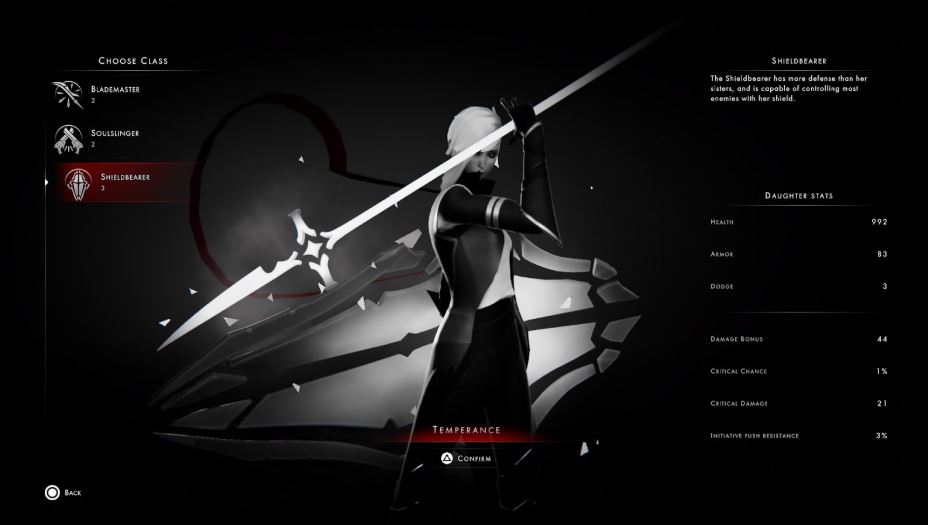
Developed by the indie studio behind Games of Glory, Lightbulb Crew, and published by Focus Home Interactive, Othercide is a tactical RPG with rogue-like elements. In it, you command an army of Daughters in your quest to defeat nightmarish, interdimensional creatures. Othercide also features a unique timeline mechanic, which allows you to control the flow of battle, disrupting the turn order for enemies on the field while setting up devastating combos between your Daughters, which you will need to surmount the horrors pitted against you. The game comes beautifully bundled in a gothic-horror package that plays as though XCOM had a baby with Lovecraft, and let it watch too much anime.

Your Daughters have specific roles to fill in combat. Most engagements allow you to have three Daughters in play, and there are three specific classes that most RPG players are familiar with: the tank, the support, and the damage dealer. As each of these classes level up, you get to dictate what abilities they gain for combat, and with a little planning, decide how they synergize with each other.
The Blademaster

The Blademaster is your primary damage dealer. She prefers close combat and has options for approaching enemies on the battlefield swiftly so she can execute them. She has the highest raw attack power, which makes her great at single combat with sturdier enemies. Despite her role on the frontlines, she is a little squishy—so if she can’t clear her targets, it’s important to have a backup plan to keep her protected.
The Shieldbearer

The Shieldbearer is the resident tank of the party. While her damage-dealing abilities are mediocre, she has access to abilities that shove her enemies around the stage, disrupting their positioning and delaying their turns. She has lots of HP and armor, allowing her to protect her sisters from harm with reduced risk to herself. Keeping her close to the Blademaster is generally a good idea, the two can set up flanking maneuvers and deal bonus damage.
The Soulslinger

The Soulslinger deals ranged damage and offers other forms of support to her sisters in combat. While her raw damage output is fairly poor, she often gets to draw first blood in combat and can rapidly clear away smaller threats. Because you don’t have to move her around on the field as much, she’s typically able to attack early and often, nickel-and-diming baddies for easy damage. As she levels up, she gets access to other support tools that cause area-of-effect damage, counter enemy attacks on her sisters, and can buff allies.

The story in Othercide is cryptic, but ambitious in scope, with lore dating back as far as when the Black Death had first emerged in Europe. The themes of the game explore the nature of memory, dreams, suffering, and sacrifice. The primary antagonist is called The Chosen One, a child that was afflicted with the plague and cursed with immortality by Suffering, a malicious deity who exists on the other side of the veil which divides reality from unreality. While this is fantastical and convoluted in classic anime fashion, it makes for a dreamy (read nightmarish) atmosphere that rightfully informs how gameplay develops the themes set forth by the story. For example, the game expects you to fail: your Daughters die, you make mistakes, and you lose battles, and eventually you’ll have to start from scratch. When this happens, it isn’t a simple “game over” and you replay, pretending like you never lost. Rather, the game keeps track of your progress and some of the upgrades you’ve obtained along the way, and you travel back to the beginning of the war against the Other, keeping the core gameplay loop an organic part of the story.

While Othercide does have cutscenes and dialogue, most of the story is delivered through item descriptions and pages of lore. This is an interesting alternative to padding playtime with exposition. The story is available if you want it, but you also have the freedom to ignore it. That being said, the world-building is hugely imaginative, and wonderfully grotesque.
The rogue-like elements of Othercide give it a lot of replayability. Progressing chapters unlock varied modifiers that enhance gameplay, while also giving room for player modulated difficulty. There is vast potential for self-imposed challenges, such as no-death runs, or playing without upgrades. While the tactical learning curve for the game is a little steep—especially with low level Daughters—finding mastery in positioning and exploiting the timeline feels very rewarding.
Othercide is a wonderful addition to tactical-RPG-lovers’ collections. Its surreal aesthetic is both haunting and mesmerizing. It is also easy to get sucked in, enough so that you might wish to rearrange your own timeline. I give Othercide a solid 9/10.
Check Out the Othercide Gameplay Overview Trailer:
Othercide is available for PlayStation 4, Xbox One, and PC via Steam. The Nintendo Switch version will be available this summer.
For more information, please visit here.
As an Amazon Associate we earn from qualifying purchases.
PlayStation 4 Review
I live and work in Portland, Oregon. I've been an achievement hunter ever since beating Mario 64 and collecting all the stars at the tender age of four. My most recent gaming achievements include getting all trophies for Sekiro: Shadows Die Twice, and beating Dark Souls 3 without leveling up or using weapon upgrades.





More Stories
DAIMON BLADES Preview for Steam Early Access
ReStory Preview for Steam
Firefighting Simulator: Ignite Releases Parker’s Story DLC for PC and Console